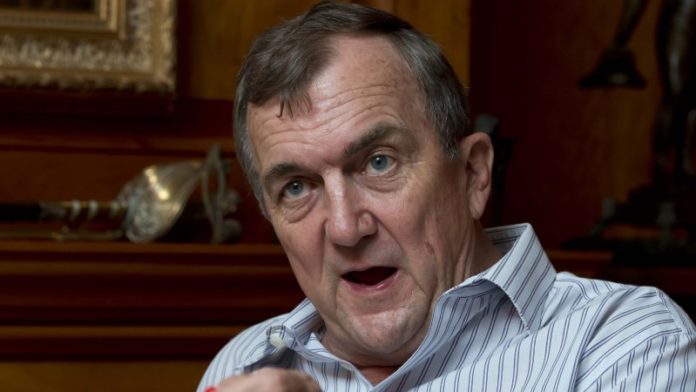
BARRICK Gold guided to production of between 5.1 and 5.6 million ounces for its 2019 financial year, less than the 5.81 million oz the recently merged firm’s constituent companies produced together last year, and all-in sustaining costs (AISC) of between $870 and $940/oz – higher than the $804/oz in AISC Barrick reported last year.
“These numbers are exactly in line with Barrick guidance; it’s just that we are declaring our production on an attributable basis,” said Mark Bristow, CEO of Barrick Gold, in accounting for how his former company Randgold Resources’ production guidance was included. He added that the increase in AISC was down to the mining out of the high grade, low-cost Cortex Hills mine. “This was known by everybody,” said Bristow.
“Higher grades, improved efficiencies, and tight cost discipline are expected to reverse this trend over the next two to three years,” Barrick Gold said.
Barrick Gold’s production guidance was published simultaneously with separate announcements representing the fourth quarter and full year numbers for Barrick Gold and Randgold Resources before they merged in January. Randgold’s fourth quarter and year-end figures also contained details of a feasibility study at Massawa, a project in Senegal which Randgold scoped for a capital cost of $430m.
Copper production would come in between 375 and 430 million pounds for the 2019 financial year (2018: 383 million pounds), Barrick said. Shares in the company fell about 3.4% by early afternoon on the Toronto Stock Exchange.
Bristow, formerly founder and CEO of Randgold Resources, said the process of honing the new group’s tier one asset profile had begun in earnest. “It’s super-exciting,” he said of a process in which assets that had been run for cash flow were being “re-cut” into organic, brownfield growth projects.
“We have rationalised the exploration and geological organisation in Barrick and it’s amazing what young people we have who are now popping up with real skills,” he said. He wants more work on Barrick’s South American assets. “Now we have resource managers in all of the operations,” he added.
He had run the rule over Barrick Gold’s North American assets, especially in the Nevada district where nearly a third of total group gold production is derived. These mines were being run as a single complex, said Bristow who also reiterated previous comments that the region provided consolidation potential.
He said today the Nevada region had “… enormous upside through brownfield extensions, new discoveries, and combination opportunities with other operators”.
Whilst still under the control of Randgold Resources, an application for a mining permit had been made to the Senegal government for Massawa. The details of the feasibility study found that pre-production and construction capital of some $430m was required in order to start mining a reserve totalling 2.4 million oz at an average grade of 4.2 grams per tonne.
Kibali and Loulo-Gounkoto, in which Randgold had shares of 45% and 80% respectively, take their place in the larger Barrick in good shape, especially the former which produced record gold of 807,000 oz, in excess of guidance and 35% higher than 2017’s output. The mines had reinforced their tier one status.
The outlook for Tongon in Côte d’Ivoire is less certain following its disappointing, strike-hit gold production contribution last year. No mention was made of Tongon’s prospects in the latest Barrick announcement today.
POLITICS
Bristow has a number of political hot potatoes to slice and dice this year including a dispute between the Tanzanian government and Acacia Mining, a UK-listed company in which Barrick has a 63.4% stake. He reiterated previous confidence that a solution was on the cards. “There’s been one big s**t-fight, but it would be remiss of me not to say that we are now moving ahead. A solution will be found and sooner rather than later.”
Barrick made no mention of a recent meeting between Bristow and the Zambia mines minister, Richard Musukwa. Musukwa told Miningmx earlier this month that a meeting between the two had gone well. Zambia has imposed a new fiscal regime that might weaken the economic case for Barrick holding the Lumwana copper mine.
Barrick said previously dismissed speculation that it had sold the mine although it couldn’t entirely dismiss the possibility of a divestiture occurring in the future.
Bristow said today, however, that Barrick couldn’t be the largest copper producer in the country and have its “arms and legs tied”. He agreed that a customised fiscal arrangement could be negotiated with the Zambians over time.
Similarly, there was optimism over the election of Felix Tshisekedi as president of the Democratic Republic of Congo which last year implemented a new mining code that gave no weight to the previous code’s stabilisation clauses. As a result, mining firms including Barrick and AngloGold Ashanti, as well as Glencore, have been asked to pay higher royalties on mining products.
“There is a desire to attract and build on the successes of past investments in the Congo,” said Bristow. “We are reshaping the relationship between the people who have been brought in to run the company and risk capital. Felix Tshisekedi and the rest of his staff are appreciative of that. There are also a lot of new MPs and there’s strong support in civil society to get some win-win, to use the cliche, for mining there,” he said.










